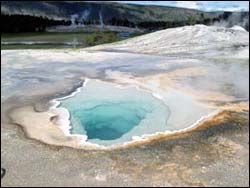Family trees of ancient bacteria reveal evolutionary moves

A hot spring at old faithful in Yellowstone National Park, Wyoming. A WUSTL scientist suggests that Cyanobacteria arose in freshwater environments rather than in the sea. Carrine Blank/WUSTL Photo
Evolution as driving force in Earth’s development
A geomicrobiologist at Washington University in St. Louis has proposed that evolution is the primary driving force in the early Earth’s development rather than physical processes, such as plate tectonics.
Carrine Blank, Ph.D., Washington University assistant professor of geomicrobiology in the Department of Earth & Planetary Sciences in Arts & Sciences, studying Cyanobacteria – bacteria that use light, water, and carbon dioxide to produce oxygen and biomass – has concluded that these species got their start on Earth in freshwater systems on continents and gradually evolved to exist in brackish water environments, then higher salt ones, marine and hyper saline (salt crust) environments.
Cyanobacteria are organisms that gave rise to chloroplasts, the oxygen factory in plant cells. A half billion years ago Cyanobacteria predated more complex organisms like multi-cellular plants and functioned in a world where the oxygen level of the biosphere was much less than it is today. Over their very long life span, Cyanobacteria have evolved a system to survive a gradually increasing oxidizing environment, making them of interest to a broad range of researchers.
Blank is able to draw her hypothesis from family trees she is drawing of Cyanobacteria. Her observations are likely to incite debate among biologists and geologists studying one of Earth’s most controversial eras – approximately 2.1 billion years ago, when cyanobacteria first arose on the Earth. This was a time when the Earth’s atmosphere had an incredible, mysterious and inexplicable rise in oxygen, from extremely low levels to 10 percent of what it is today. There were three – some say four – global glaciations, and the fossil record reflects a major shift in the number of organisms metabolizing sulfur and a major shift in carbon cycling.
“The question is: Why?” said Blank.
“My contribution is the attempt to find evolutionary explanations for these major changes. There were lots of evolutionary movements in Cyanobacteria at this time, and the bacteria were making an impact on the Earth’s development. Geologists in the past have been relying on geological events for transitions that triggered change, but I’m arguing that a lot of these things could be evolutionary.”
Blank presented her research at the 2004 annual meeting of the Geological Society of America, held, Nov. 7-10 in Denver.
Blank’s finding that Cyanobacteria emerged first in fresh water lakes or streams is counterintuitive.
“Most people have the assumption that Cyanobacteria came out of a marine environment – after all, they are still important to marine environments today, so they must always have been,” Blank said. “When Cyanobacteria started to appear, there was no ozone shield, so UV light would have killed most things. They either had to have come up with ways to deal with the UV light – and there is evidence that they made UV-absorbing pigments – or find ways of growing under sediments to avoid the light.”
To study the evolution of Cyanobacteria, Blank drew up a backbone tree using multiple genes from whole genome sequences. Additional species were added to the tree using ribosomal RNA genes. Morphological characters, for instance, the presence or absence of a sheath, unicellular or filamentous growth, the presence or absence of heterocysts — a thick-walled cell occurring at intervals — were coded and mapped on the tree. The distribution of traits was compared with those found in the fossil record.
Cyanobacteria emerging some two billion years ago were becoming complex microbes that had larger cell diameters than earlier groups – at least 2.5 microns. Blank’s tree shows that several morphological traits arose independently in multiple lines, among them a sheath structure, filamentous growth, the ability to fix nitrogen, thermophily (love of heat), motility and the use of sulfide as an electron donor.
“We will need lots of analyses of the micro-fossil record by serious paleobiologists to see how sound this hypothesis is,” Blank said. “This time frame is one of the biggest puzzles for biologists and geologists alike. A huge amount of things are happening then in the geological record.”
Media Contact
More Information:
http://www.wustl.eduAll latest news from the category: Earth Sciences
Earth Sciences (also referred to as Geosciences), which deals with basic issues surrounding our planet, plays a vital role in the area of energy and raw materials supply.
Earth Sciences comprises subjects such as geology, geography, geological informatics, paleontology, mineralogy, petrography, crystallography, geophysics, geodesy, glaciology, cartography, photogrammetry, meteorology and seismology, early-warning systems, earthquake research and polar research.
Newest articles

Breaking the Ice: Glacier Melting Alters Arctic Fjord Ecosystems
The regions of the Arctic are particularly vulnerable to climate change. However, there is a lack of comprehensive scientific information about the environmental changes there. Researchers from the Helmholtz Center…

Global Genetic Insights into Depression Across Ethnicities
New genetic risk factors for depression have been identified across all major global populations for the first time, allowing scientists to predict risk of depression regardless of ethnicity. The world’s…

Back to Basics: Healthy Lifestyle Reduces Chronic Back Pain
Low back pain is a leading cause of disability worldwide with many treatments, such as medication, often failing to provide lasting relief. Researchers from the University of Sydney’s Centre for Rural…



